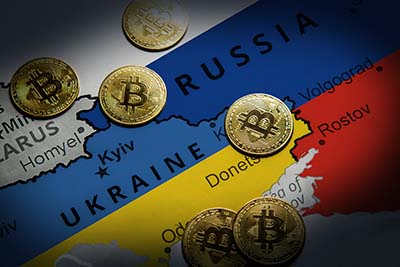
While the world is shaken by the Russian Invasion in Ukraine, it is worth discussing how it is affecting the crypto market. The crypto advocates have always claimed Bitcoin as “the digital gold” as it is not expected to fluctuate due to wars, geopolitical tensions, or other calamities. However, the way bitcoin plunges (as well as other cryptos) to the first significant war in its tenure has already made the claim quite questionable. There is another side of the story. This article will discuss how the price drops of bitcoin and other cryptocurrencies have reacted to the burning international issue and what we need to learn from it. We will also try to find out how these series of events would change the general perspective of cryptocurrency as an investment to the mass public.
How are the price of cryptocurrencies determined?
Cryptocurrencies are often unsupervised and unbacked by any official authority. Government support may boost public confidence in the currency’s value, and it may provide a significant spender and collector of the currency. (Try paying your taxes using Bitcoin for a really unique experience.) However, due to the decentralized nature of cryptocurrencies, they obtain their value from a multitude of sources, including the index of supply and demand, availability in centralized exchanges, mining costs, competition, regulation, and so on.
To be explicit, inflation and economic infrastructure are not included in the above explanations. However, prominent cryptocurrencies saw a massive decline after the formal announcement of the invasion. What truly pushed the market down was traders’ panic and concern that the crypto market would crash just like the stock market. As a consequence, a large number of sellers liquidated their holdings and exited the market. This sell-off boosted the supply, resulting in a precipitous decrease in the value of the largest cryptocurrencies.
Specific asset discussion
Bitcoin
On February 24, 2022, Russian President Vladimir Putin declared the invasion. As soon as the news spread, Bitcoin (CRYPTO: BTC), the first and largest cryptocurrency by market capitalization, fell to $35,000, a 7.26% drop from the previous day’s price. Within a few hours of the announcement, the market cap of $87 billion had been wiped out.
The traders’ panic-selling attitude was the primary cause of the market’s crash. The majority of the traders have prior experience in the stock market. As a result, when the stock market plummeted following the invasion announcement, some big traders expected the crypto market to follow suit. As a result, they sold a significant portion of their portfolio to be safe. Thus, despite having no direct connection to the invasion, bitcoin suffered a massive drop.
The narrative, however, is far from done. The traders who sold their assets realized that their trading attitude was irrelevant. When they learned that a decentralized exchange like cryptocurrency could be the only and best solution for payments and donations in the face of dozens of economic sanctions imposed around the world, the hype resurfaced.
As a result, on February 25, a large number of purchases were made, and the price of bitcoin climbed to $38,764, a 9.71% increase over the previous day. Within a week of the abrupt drop, bitcoin rose to its long-term resistance of $45000 and began returning to support as usual on March 2, 2022.
Ethereum
Ethereum (CRYPTO: ETH), the second-largest cryptocurrency, initially followed bitcoin’s lead. However, on February 24, 2022, the token fell to $2300, a fall of 12.28 percent from the previous day. Ethereum’s market capitalization fell to roughly $280 billion overnight, a loss of $47 billion.
Although the Ethereum project is fundamentally distinct from bitcoin, Ethereum has historically tracked Bitcoin’s price movements. Once again, the price shift caused by the invasion demonstrated the fact. Ethereum, like bitcoin, has recovered in the last few days. On February 26, 2022, it increased by around 22.9%, reaching a price of nearly $2817. By the month’s end, it had risen to $3021.
Other Altcoins
As always, all the other Altcoins followed bitcoin through the dump and pump on February 24 and afterward. Here are some stats to be more specific:
| Cryptocurrency | Decrease rate on 24 February 2022 | Decreased price on 24 February 2022 |
| Shiba Inu | 21.65% | 0.00002124 |
| Solana | 17.09% | 76.58 |
| XRP | 14.98% | 0.6287 |
| DOGE | 18.62% | 0.1097 |
Conclusion
As we can see from the above, circumstances of war and geopolitical tensions continue to affect the crypto market. Therefore, we should trade more cautiously during these periods regardless of the market’s favorable condition. Before risking our hard-earned money, we should examine and recalculate every possibility.
Story by Monir Mousa










